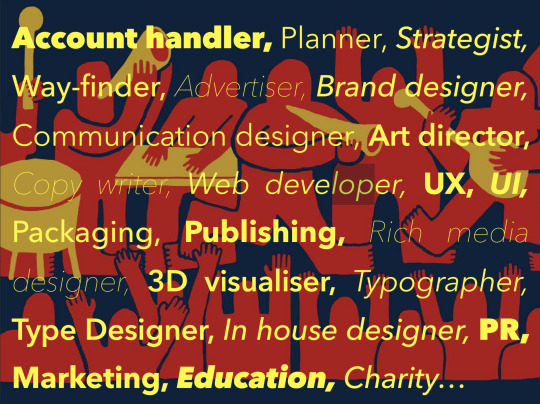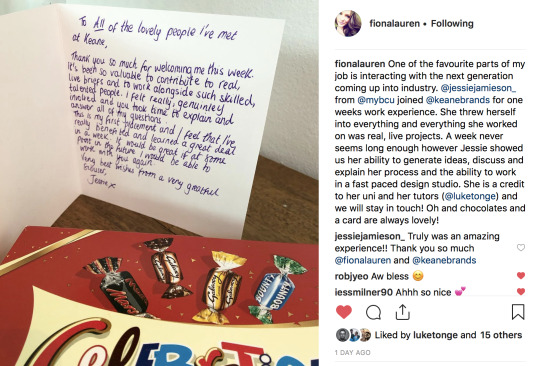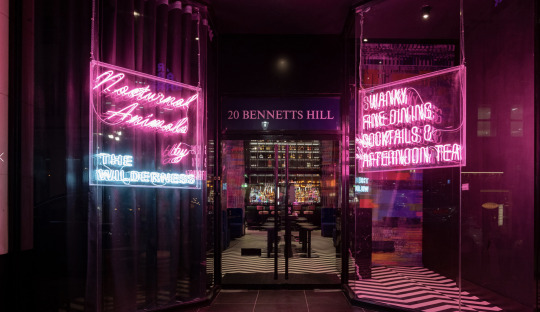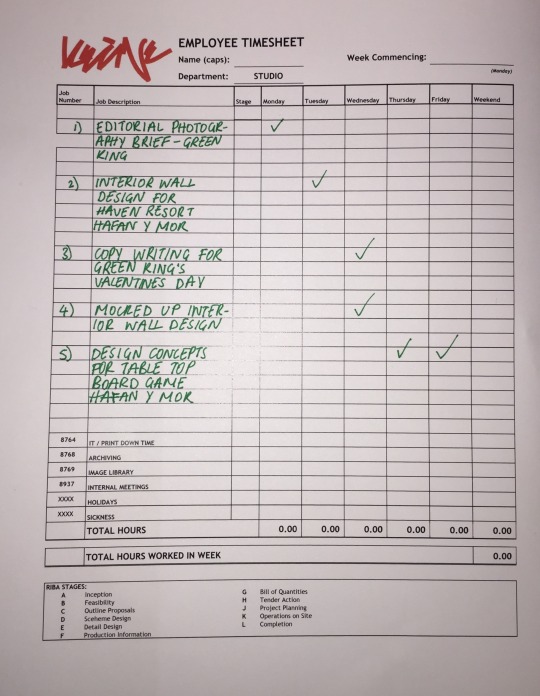Don't wanna be here? Send us removal request.
Video
youtube
‘At some point in our lives we all want to create a powerful legacy and make a positive contribution to the world. Becoming an organ donor is the first heroic step to creating this legacy – the gift of life. Live Life Give Life is committed to celebrating organ donation and inspiring the individual to leave a positive legacy that lasts for generations. Our goal is to motivate everyone in the UK to register as an organ donor. We want people from all walks of life to sign-up to the NHS Organ Donor Register, and to speak-up and share the decision they’ve made. Have you had the conversation with your loved ones?’
Roydon Turner - Executive Creative director & Founding partner Life Life Give Life
0 notes
Video
youtube
Two+Two intro video. There should be more posts to follow about the involvement that I have had in this one day course
0 notes
Text
Two + Two
Had such an amazing experience working today with Creative Resource on their #twoplustwo day event. Truly got some great insight into inner industry workings, met some amazingly talented students and incredibly accommodating and inspiring industry professionals. Our brief set by #havaslynx and #lifelifegivelife allowed students of all creative backgrounds to collaboratively work together. Got so much out of the day, will definitely be back next year!! #McCannManchester #Creativeresource #bjl #plushealthcare #talkingdonation



0 notes
Text
Inspired by Bruce Mau...
My ongoing Manifesto:
Paint and draw more, get back to my fine art roots.
Create art for no reason, no purpose and see where it takes me.
Get a placement(s) in an advertising agency within an Art Diction/Copy writing field.
Refine my skills in the Adobe suite, feel confident.
Gain employment after graduation within the advertising field.
After gaining multiple placement opportunities, solidify the definite root(s) of employment I want to go down.
Push myself out of my comfort zone in terms of visual outputs and outcomes.
Make links with northern creative agencies, ideally in Manchester.
Find a definitive visual style and develop it, even if its within one specific area of design communication.
...
0 notes
Text
Bruce Mau
AN INCOMPLETE MANIFESTO FOR GROWTH
Allow events to change you. You have to be willing to grow. Growth is different from something that happens to you. You produce it. You live it. The prerequisites for growth: the openness to experience events and the willingness to be changed by them.
Forget about good. Good is a known quantity. Good is what we all agree on. Growth is not necessarily good. Growth is an exploration of unlit recesses that may or may not yield to our research. As long as you stick to good you’ll never have real growth.
Process is more important than outcome. When the outcome drives the process we will only ever go to where we’ve already been. If process drives outcome we may not know where we’re going, but we will know we want to be there.
Love your experiments (as you would an ugly child). Joy is the engine of growth. Exploit the liberty in casting your work as beautiful experiments, iterations, attempts, trials, and errors. Take the long view and allow yourself the fun of failure every day.
Go deep. The deeper you go the more likely you will discover something of value.
Capture accidents. The wrong answer is the right answer in search of a different question. Collect wrong answers as part of the process. Ask different questions.
Study. A studio is a place of study. Use the necessity of production as an excuse to study. Everyone will benefit.
Drift. Allow yourself to wander aimlessly. Explore adjacencies. Lack judgment. Postpone criticism.
Begin anywhere. John Cage tells us that not knowing where to begin is a common form of paralysis. His advice: begin anywhere.
Everyone is a leader. Growth happens. Whenever it does, allow it to emerge. Learn to follow when it makes sense. Let anyone lead.
Harvest ideas. Edit applications. Ideas need a dynamic, fluid, generous environment to sustain life. Applications, on the other hand, benefit from critical rigor. Produce a high ratio of ideas to applications.
Keep moving. The market and its operations have a tendency to reinforce success. Resist it. Allow failure and migration to be part of your practice.
Slow down. Desynchronize from standard time frames and surprising opportunities may present themselves.
Don’t be cool. Cool is conservative fear dressed in black. Free yourself from limits of this sort.
Ask stupid questions. Growth is fuelled by desire and innocence. Assess the answer, not the question. Imagine learning throughout your life at the rate of an infant.
Collaborate. The space between people working together is filled with conflict, friction, strife, exhilaration, delight, and vast creative potential.
____________________. Intentionally left blank. Allow space for the ideas you haven’t had yet, and for the ideas of others.
Stay up late. Strange things happen when you’ve gone too far, been up too long, worked too hard, and you’re separated from the rest of the world.
Work the metaphor. Every object has the capacity to stand for something other than what is apparent. Work on what it stands for.
Be careful to take risks. Time is genetic. Today is the child of yesterday and the parent of tomorrow. The work you produce today will create your future.
Repeat yourself. If you like it, do it again. If you don’t like it, do it again.
Make your own tools. Hybridize your tools in order to build unique things. Even simple tools that are your own can yield entirely new avenues of exploration. Remember, tools amplify our capacities, so even a small tool can make a big difference.
Stand on someone’s shoulders. You can travel farther carried on the accomplishments of those who came before you. And the view is so much better.
Avoid software. The problem with software is that everyone has it.
Don’t clean your desk. You might find something in the morning that you can’t see tonight.
Don’t enter awards competitions. Just don’t. It’s not good for you.
Read only left–hand pages. Marshall McLuhan did this. By decreasing the amount of information, we leave room for what he called our ‘noodle’.
Make new words. Expand the lexicon. The new conditions demand a new way of thinking. The thinking demands new forms of expression. The expression generates new conditions.
Think with your mind. Forget technology. Creativity is not device–dependent.
Organization = Liberty. Real innovation in design, or any other field, happens in context. That context is usually some form of cooperatively managed enterprise. Frank Gehry, for instance, is only able to realize Bilbao because his studio can deliver it on budget. The myth of a split between ‘creatives’ and ‘suits’ is what Leonard Cohen calls a “charming artifact of the past.”
Don’t borrow money. Once again, Frank Gehry’s advice. By maintaining financial control, we maintain creative control. It’s not exactly rocket science, but it’s surprising how hard it is to maintain this discipline, and how many have failed.
Listen carefully. Every collaborator who enters our orbit brings with him or her a world more strange and complex than any we could ever hope to imagine. By listening to the details and the subtlety of their needs, desires, or ambitions, we fold their world onto our own. Neither party will ever be the same.
Take field trips. The bandwidth of the world is greater than that of your TV set, or the Internet, or even a totally immersive, interactive, dynamically rendered, object–oriented, real–time, computer graphic–simulated environment.
Make mistakes faster. This isn’t my idea—I borrowed it. I think it belongs to Andy Grove.
Imitate. Don’t be shy about it. Try to get as close as you can. You’ll never get all the way, and the separation might be truly remarkable. We have only to look to Richard Hamilton and his version of Marcel Duchamp’s large glass to see how rich, discredited, and underused imitation is as a technique.
Scat. When you forget the words, do what Ella did: make up something else… but not words.
Break it, stretch it, bend it, crush it, crack it, fold it.
Explore the other edge. Great liberty exists when we avoid trying to run with the technological pack. We can’t find the leading edge because it’s trampled underfoot. Try using old–tech equipment made obsolete by an economic cycle but still rich with potential.
Coffee breaks, cab rides, green rooms. Real growth often happens outside of where we intend it to, in the interstitial spaces—what Dr. Seuss calls “the waiting place.” Hans Ulrich Obrist once organized a science and art conference with all of the infrastructure of a conference—the parties, chats, lunches, airport arrivals—but with no actual conference. Apparently it was hugely successful and spawned many ongoing collaborations.
Avoid fields. Jump fences. Disciplinary boundaries and regulatory regimes are attempts to control the wilding of creative life. They are often understandable efforts to order what are manifold, complex, evolutionary processes. Our job is to jump the fences and cross the fields.
Laugh. People visiting the studio often comment on how much we laugh. Since I’ve become aware of this, I use it as a barometer of how comfortably we are expressing ourselves.
Remember. Growth is only possible as a product of history. Without memory, innovation is merely novelty. History gives growth a direction. But a memory is never perfect. Every memory is a degraded or composite image of a previous moment or event. That’s what makes us aware of its quality as a past and not a present. It means that every memory is new, a partial construct different from its source, and, as such, a potential for growth itself.
Power to the people. Play can only happen when people feel they have control over their lives. We can’t be free agents if we’re not free.
0 notes
Text
Goal setting + visualising your future
Who are you? What are your ambitions? What are the opportunities?
Today we had the launch of our brand new module Identifying Direction. In this module we will ‘explore possible approaches, areas of research, and projects that will help define your area of practice, reflecting upon the range of experiences through level 4 and 5 to allow you to identify a specific direction for your study into level 6.’

David got us to partake in a group exercise where we had to picture our career and future in five years time. We had to visualise where we would be living, who with, where we would be working, what we’d be doing, what position we would be in, how far away from our home would our work place be, if our work place would be our home, how long we’d be working for and what we’d be doing etc.
I found this exercise really helpful and it allowed me to think about prospects I haven’t before. Often we get so caught up thinking about the agency we want to be working in but we don’t pair it up with the lifestyle we want to live alongside it.
What do I want to do?
At the minuite I am really interested in Advertising. Within that sector, Art direction, copy writing and strategy interests me. I really enjoy the creative process of research and thinking. I love being able to solve a problem/think of a solution to a complicated brief. Ideation is a big part of how I work, the ideas process mixed in with research on a set target audience is interesting to me.
At the minute I’m just trying to get as much experience within industry to see where I want to be. I am trying to secure some more placements within different sectors, hopefully that will help me figure out what job role I am most suited to
0 notes
Text
Identifying direction - Module Launch
Key Dates
Work Check 1 - 25th February
PF Presentation - 8th April (Feedback - 29th April)
RVD Submission - 28th May (Feedback - 10th June)
We will be producing:
L01, L02, L04: 75%
- RVD (Reflective Visual Document): Theory behind practice, research, YCN brief, a Guided goal-setting exercise: identifying your ambitions
- the exploration of a YCN brief that challenges your knowledge and understanding of a defined area of practice. (within RVD)
L03 25%
Professional Futures Presentation: To present yourself, highlight your skills and experiences, and to apply the Professional Futures lectures to your own journey
Lectures:
- Industry-focused Professional Futures lectures. 4-5pm in room p350 on Mondays.
Everything in more detail
LO1, LO2, LO4
RVD: This is a refined document which will focus on the body of work you have produced for the Identifying Direction module. Through this reflective document, you will analyse the development of your project work and your final outcomes, as well as identifying connections with theory and contemporary practice. This will allow you to clarify your own individual direction, and to consider routes for exploration at L6.
Planning and development of your personal project:
- don’t forget to think about the context of your work and your target audience;
- Review of appropriate academic literature in relation to your personal project;
-Consideration of contemporary and historical practitioners in relation to your personal project;
-Your personal project’s final outcomes.
1. Cover Page
The cover page of your RVD should include your name, your student number, module code (VIS5041), your project title, and your word count.
2. Contents
The contents page should clearly set out all the components of your RVD. Don’t forget to include page numbers.
3. Introduction
The introduction should set out the purpose and scope of the project undertaken; explaining what it is about and why the research is necessary. It should, therefore, include:
• Background and rationale: briefly introducing and explaining the subject of the personal project;
• Aim(s): a clear and precise statement of the aims and
• Research methods: a summary of how the research objectives were met;
• Overview of the document’s structure.
You do not need to split the introduction into separate parts, as long as you address the above points. Your introduction should be around 500 words in length.
After the introduction will come the main body of your RVD. This is the most substantial component of your RVD, and the written components of it should be in the region of 2,000 words in length. In terms of structuring it, this will vary according to the nature of your personal project. It should, however, address the following;
LO3
Professional Futures Presentation:This is a 10-minute presentation that explores your approach to professional practice, as well as looking towards L6 and beyond. This is an opportunity to present yourself, highlight your skills and experiences, and to apply the Professional Futureslectures to your own journey. This presentation should go beyond a simple PowerPoint; it should be a well-considered, rehearsed, polished, and professional presentation. This will take the form of an individual presentation in front of staff and peers. You will be provided with a template to follow for this presentation (see Moodle).
You will actively identify and pursue career opportunities
0 notes
Text
Keane - Day 5

On my last day I finished off looking at the table top board games and scampped them up to show the the rest of the team.
Overall, I am so glad that I got the chance to work within this agency for a week and am truly grateful for the time that all of the staff put in to help me and answer my questions. I really hope that I get to visit them again and hopefully create more work together!
Truly an amazing experience!
0 notes
Text
Keane - Day 4
On day four I was asked to run with the table top board games. I was given the table’s dimensions and a floor plan of the restaurant and where each table would be located. I was tasked to design for two tables of six and one table of four. I was asked to think about spins on traditional board games such as tic, tac, toe, snakes and ladders and other board games. There had to be a theme relating to either the seaside or woods and the forest as this particular part of the restaurant had mini tree houses. I was also told that there wasn't a large budget on this mini project and that they wanted to keep the board game pieces to a minimum as they don’t want them to get lost in a restaurant environment.




0 notes
Text
Keane - Day 3
In the morning I was asked to come up with one line for a fairy tale themed poster promoting a carver offer. I was shown other work Keane had done for this client and started to come up with some lines to get them reviewed.
For the other half of the day, my task was to amalgamate the work that me and Rob did for the interior wall design in a bar area. This was a great task to do and really enjoyed working on a task that was out of my comfort zone.
At the end of the day, I was asked to think about alternative designs for a table top themed board game area within the same restaurant, so I mind mapped up those ideas.



0 notes
Text
Keane - Day 2
On day two I was put on to an interior design task with a free lance graphic designer Rob. Me and Rob were briefed to create some feature wall design within a restaurant and bar area for a popular holiday resort company. This wall consisted of an alcove that sat behind a table and chairs and then connected onto a larger wall opposite the bar area. We were shown a ‘fly through’ motion video that the architects created upstairs. This gave us a colour palette to work with and a theme of seaside imagery to work with. After a couple of hours me and rob came together with a mood board and ran by our ideas to each other. We then decided to stick with two to mock up for the end of the day. My idea focussed on stripped back, sanded wood panels incorporating some of the key colours from the restaurant but in a wash style. I also focussed on mood lighting ideas and how this would change depending on the time of day. By the end of the day, our work was reviewed and Jess a brand communicator liked aspects from both mine and Robs ideas for the final designs.

0 notes
Text
Keane - Day 1

On my first day, I was introduced to everyone in the team and also introduced to operate working teams within the building. Everyone’s working relationships and roles were explained to me and I got to meet a lot of very talented individuals. Keane had such a lovely family vibe to it. All of the staff were really accommodating and were genuinely interested in what I was studying and interested in pursuing career wise.
I was put onto a live editorial photography brief for a shoot commencing in London in the upcoming weeks. This was for a very popular branch of pub chain that has hundreds of sights around the UK. I was asked to find very specific images for a mood board to present to a food stylist and photographer that were rebranding a day time meal menu for the pub.
It was a very interesting task as I had to find a certain resolution quality of image and the style of the photography had to be ‘over head photography’. I then was asked to place images within a guide in Indesign and annotate and explain my findings.
One of the things I questioned was how the designers can look at food images all day without having to constantly eat!
I really enjoyed day one and was excited about what the next day would bring.

0 notes
Text
A weeks placement at Keane Brands!
Last week, I embarked on a weeks placement at Keane Brands. ‘We create and communicate restaurants, bars, clubs and more – on every continent. From beautiful high-end restaurant design to outstanding casual dining roll-outs and quirky, street-wise bars to multi-room night clubs.’

This experience opened up my eyes to what its like to work in a fast paced agency, what roles people take on within an agency and so much more. Keane has three main floors. On the ground floor there is a team of Art Directors, Copy writers, Client service communicators and brand strategists. I learned that briefs are written by the team downstairs and often the communication with clients and the agency is done by the brand communicators. They then devise a brief and work on time scales and budgets and communicate what the client wants and when they want it to 2D design, art workers, 3D design and interior architects.
I was based on the 2nd floor within the 2D design team. We were briefed from downstairs and given paper copies of what the client wanted and when it was expected. I was really happy to be put on real life briefs with real clients and I got the chance to work with and alongside all of the designers.

0 notes
Video
tumblr
(pardon Jaime’s language)................
We went on an ‘artsy interior’ crawl to find some cool interior design features. This is a walkway within Nocturnal Animals. This design was conceived by Alex Claridge to create a fun and inventive experience and fun and inventive it certainly was!

This is a sign displayed within the ladies toilets. All of the toilets were tiled from top to bottom in bright primary colours. It felt like a mash up of a kids play area and an art exhibition.


0 notes
Link
I have also set up a linkedIn account and have found this really useful with making industry connections. I feel as though this platform has educated me so much on current news events happening within the design industry. It has opened up job opportunities and placement opportunities and I will definitely continue to work on expanding my profile to make more connections with like minded, professional individuals.
0 notes
